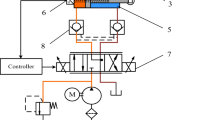Abstract
High speed small hole electrical discharge machining (EDM) drilling processes can easily become unstable, due to changing flushing conditions, inappropriate preset electrical parameters, and machining debris residues. Although there are already successful attempts in controlling EDM processes, cost-effective adaptive control of high speed small hole EDM drilling has not been reported. Process stability can contribute to the improvement of machining efficiency and surface finish. To maintain a higher process stability, a minimum-variance self-tuning regulator (MVSTR) is designed based on an auto-regressive moving average exogenous (ARMAX) model. To determine specifications of the system, the time and frequency responses are analyzed, and the validation is executed for the offline system model. A series of high aspect ratio holes drilling experiments with different electrode diameters of 0.3 mm, 1.0 mm, and 3.0 mm show that, with the use of the MVSTR control scheme, a higher machining efficiency and a lower tool wear can be achieved as compared with the original controller. Microscopic pictures of drilled holes and electrodes show better surface quality.












Similar content being viewed by others
References
Ferraris E, Castiglioni V, Ceyssens F, Annoni M, Lauwers B, Reynaerts D (2013) EDM drilling of ultra-high aspect ratio micro holes with insulated tools. CIRP Ann Manuf Technol 62(1):191–194
Kim DW, Lee YS, Park MS, Chu CN (2009) Tool life improvement by peck drilling and thrust force monitoring during deep-micro-hole drilling of steel. Int J Mach Tools Manuf 49(3-4):246–255
Ke F, Ni J, Stephenson DA (2006) Chip thickening in deep-hole drilling. Int J Mach Tools Manuf 46(12-13):1500–1507
Dong G, Zhang L (2019) Investigation on grinding force and machining quality during rotary ultrasonic grinding deep-small hole of fluorophlogopite ceramics. Int J Adv Manuf Technol 104(5-8):2815–2825
Gao Q (2018) Impact of electrode length on EDM inclined hole drilling process. Int J Adv Manuf Technol 94(1-4):1171–1175
Yilmaz O, Okka MA (2010) Effect of single and multi-channel electrodes application on EDM fast hole drilling performance. Int J Adv Manuf Technol 51(1-4):185–194
Xia W, Li Z, Zhang Y, Zhao W (2020) Breakout detection for fast EDM drilling by classification of machining state graphs. Int J Adv Manuf Technol 106(5-6):1645–1656
Koshy P, Boroumand M, Ziada Y (2010) Breakout detection in fast hole electrical discharge machining. Int J Mach Tools Manuf 50(10):922–925
Mueller RL (1995) Apparatus and method for fast hole drilling by electrical discharge machining, Google Patents
Kuppan P, Rajadurai A, Narayanan S (2008) Influence of EDM process parameters in deep hole drilling of inconel 718. Int J Adv Manuf Technol 38(1-2):74–84
Leão FN (2007) Optimisation of EDM fast hole drilling for aerospace applications. Ph.D. Thesis, The University of Nottingham
Rajurkar KP, Wang WM, Lindsay D (1989) A new model reference adaptive control of EDM. CIRP Ann Manuf Technol 38(1):183–186
Rajurkar KP, Wang WM, Lindsay RP (1990) Real-time stochastic model and control of EDM. CIRP Ann Manuf Technol 39(1):187–190
Zhou M, Han F (2009) Adaptive control for EDM process with a self-tuning regulator. Int J Mach Tools Manuf 49(6):462–469
Lennart L (1999) System identification: theory for the user, 2nd edn. PTR Prentice Hall, Upper Saddle River
Akaike H (1998) Information theory and an extension of the maximum likelihood principle. Selected papers of Hirotugu Akaike. Springer, New York
Rissanen J (1978) Modeling by shortest data description. Automatica 14(5):465–471
Åström KJ, Wittenmark B (1995) Adaptive control, 2nd edition, Addison-Wesley, Reading, Massachusetts
Landau DI, Zito G (2006) Digital control systems: design, identification and implementation. Springer-Verlag, London
Niu S, Fisher DG, Xiao D (1992) An augmented ud identification algorithm. Int J Control 56(1):193–211
Xi XC, Hong GS, Poo AN (2010) Improving CNC contouring accuracy by integral sliding mode control. Mechatronics 20(4):442–452
Behrens AW, Ginzel J, Bruhns FL (2004) Threshold technology and its application for gap status detection. J Mater Process Technol 149(1-3):310–315
Funding
This research is financially supported by National Science and Technology Major Project of China (No. 2018ZX04005001), National Natural Science Foundation of China (No. 51675340), Shenzhen Basic Research Program (Grant No. JCYJ20170811160440239).
Author information
Authors and Affiliations
Corresponding author
Additional information
Publisher’s note
Springer Nature remains neutral with regard to jurisdictional claims in published maps and institutional affiliations.
Rights and permissions
About this article
Cite this article
Xi, XC., Ye, L., Yu, JH. et al. Minimum-variance self-tuning regulator in EDM drilling processes for ultra-high-aspect-ratio small holes. Int J Adv Manuf Technol 111, 3293–3303 (2020). https://doi.org/10.1007/s00170-020-06285-8
Received:
Accepted:
Published:
Issue Date:
DOI: https://doi.org/10.1007/s00170-020-06285-8




